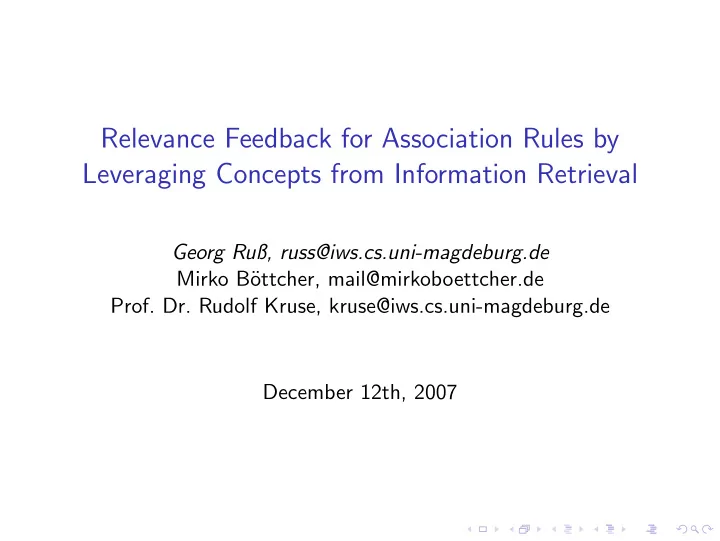

Relevance Feedback for Association Rules by Leveraging Concepts from Information Retrieval Georg Ruß, russ@iws.cs.uni-magdeburg.de Mirko Böttcher, mail@mirkoboettcher.de Prof. Dr. Rudolf Kruse, kruse@iws.cs.uni-magdeburg.de December 12th, 2007
Outline Association Rules Concepts from Information Retrieval Rule Similarity Relevance Scoring Conclusion
Motivation ◮ Large amounts of transactional data ◮ Association rule mining yields rules as a condensed representation ◮ Form: IF item 1 , item 2 , . . . , item n THEN item m ◮ Problem: still too many rules to analyze ◮ Topic: find interesting association rules
Association Rules – Formalization ◮ Set D of transactions T ∈ D . ◮ Transaction T is a subset of a set of items L . ◮ A subset X ⊆ L is called itemset . ◮ A transaction T supports an itemset X if X ⊆ T . ◮ An association rule r is an expression X → Y where X and Y are itemsets, |Y| > 0 and X ∩ Y = ∅ . ◮ X : body, Y : head ◮ Rule reliability: confidence conf ( r ) = P ( Y | X ) ◮ Statistical significance: support supp ( r ) = P ( XY ) ◮ Time series: confidence and support of one rule over time
Linking to Information Retrieval ◮ Interestingness of rules is subjective. ◮ Finding interesting rules requires user input. ◮ Manual specification of user’s knowledge ◮ key aspects are often forgotten ◮ requires expert user ◮ knowledge changes ◮ hard to specify at beginning of analysis
Information Retrieval – Relevance Feedback ◮ Automatic acquisition of user’s knowledge through actions ◮ user rates what he sees ◮ easy (binary) decision: interesting / not interesting ◮ system collects user’s choices and updates results ◮ Relevance Feedback known from Information Retrieval ◮ association rules are presented (possibly pre-ordered) ◮ user can examine and rate them ◮ an internal ranking is adapted ◮ best results are presented ◮ cycle starts over
Rule Representation – Informal ◮ Use existing algorithms for relevance feedback from IR ◮ Represent rules as vectors ◮ body head � �� � � �� � � r = ( r 1 , . . . , r b , r b + 1 , . . . , r b + h , r b + h + 1 , . . . , r b + h + t ) (1) � �� � � �� � symbolic timeseries ◮ item weights: TF-IDF approach ◮ high weight: term frequent in rule (TF), but less frequent in rule set (IDF) ◮ filters commonly used terms, captures perceived relevance
Rule Representation – Maths ◮ term frequency � 1 if x ∈ r , tf ( x , r ) = (2) 0 otherwise . ◮ inverse document frequency idf ( x , R ) = 1 − ln | r : r ∈ R ∧ x ∈ r | (3) ln | R | ◮ A rule’s feature vector is filled as follows: ◮ r i = tf ( x i , r ) · idf ( x i , R ) , i = 1 , . . . , b (4) ◮ r b + j = tf ( x j , r ) · idf ( x j , R ) , j = 1 , . . . , h (5) ◮ r timeseries . . . respective time-variant properties of rule
Interestingness of Rules ◮ Idea: compare the same features of different rules ◮ Interestingness based on (dis-)similarity ◮ Six combinations deemed interesting: dissimilar time series symbolic body head similar head - ω 4 ω 5 - body ω 1 - ω 6 - time series - - - ω 2 symbolic - - - ω 3 Table: Interestingness Matrix
Pairwise Similarity ◮ Similarity between rules as measure of interestingness ◮ Similarity can easily be computed by similarity measures for vectors ◮ Cosine similarity: � n i = 1 r i s i sim ( � r ,� s ) = (6) � � r 2 s 2 i i ◮ Dissimilarity: dissim ( � r ,� s ) = 1 − sim ( � r ,� s ) (7)
Similarity Aggregation – first step ◮ Similarity between rule and rule set: sim rs ( � r , R ) = Ω( { sim ( � r ,� s 1 ) , . . . , sim ( � r ,� s m ) } ) (8) ◮ Dissimilarity analogously to Equation 7: dissim rs ( � r , R ) = 1 − sim rs ( � r , R ) (9)
Similarity Aggregation – second step ◮ Use OWA operator to aggregate single similarities: ◮ weighting vector W = ( w 1 , w 2 , . . . , w n ) T with w j ∈ [ 0 , 1 ] and � n j = 1 w j = 1 ◮ n � Ω( { s 1 , s 2 , . . . , s n } ) = (10) w j b j , j = 1 with b j being the j -th largest of the s i .
Relevance Scoring ◮ Score calculation for each association rule ◮ User selects rule r as interesting ◮ determine interesting combinations: ◮ rules with similar head, but different body ◮ rules with similar body, but dissimilar head ◮ six combinations (see Table 1) ◮ Calculate weighted sum of the score part in those six combinations ◮ Yields a relevance score for each association rule ◮ Sort rules by score – interesting ones assumed to have high score
Conclusion ◮ Similarity-based interestingness of association rules ◮ Incorporation of relevance feedback to find interesting rules ◮ User-specific, automatic adaptation ◮ Simple relevance scoring to assess interestingness
Recommend
More recommend